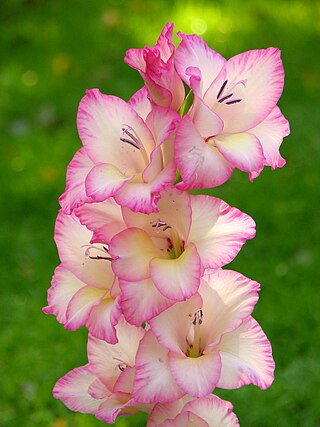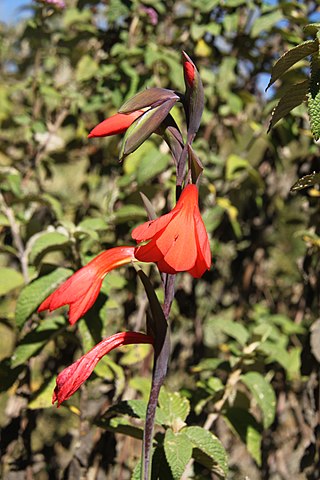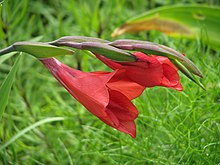
Amaryllis is the only genus in the subtribe Amaryllidinae. It is a small genus of flowering bulbs, with two species. The better known of the two, Amaryllis belladonna, is a native of the Western Cape region of South Africa, particularly the rocky southwest area between the Olifants River Valley and Knysna.

Iridaceae is a family of plants in order Asparagales, taking its name from the irises. It has a nearly global distribution, with 69 accepted genera with a total of c. 2500 species. It includes a number of economically important cultivated plants, such as species of Freesia, Gladiolus, and Crocus, as well as the crop saffron.

Gloriosa is a genus of 12 species in the plant family Colchicaceae, and includes the formerly recognised genus Littonia. They are native in tropical and southern Africa to Asia, and naturalised in Australia and the Pacific as well as being widely cultivated. The most common English names are flame lily, fire lily, gloriosa lily, glory lily, superb lily, climbing lily, and creeping lily.

Gladiolus is a genus of perennial cormous flowering plants in the iris family (Iridaceae).

Banksia praemorsa, commonly known as the cut-leaf banksia, is a species of shrub or tree in the plant genus Banksia. It occurs in a few isolated populations on the south coast of Western Australia between Albany and Cape Riche.

Aloe arborescens, the krantz aloe or candelabra aloe, is a species of flowering succulent perennial plant that belongs to the genus Aloe, which it shares with the well known and studied Aloe vera. The specific epithet arborescens means "tree-like". Aloe arborescens is valued by gardeners for its succulent green leaves, large vibrantly-colored flowers, winter blooming, and attraction for birds, bees, and butterflies.

Greyia flanaganii, commonly known as the Kei bottlebrush, is a species of plant in the Francoaceae family. Greyia flanaganii is one of the related species of the taxonomically isolated and endemic southern African family, the Greyiaceae. Greyia flanaganii is endemic to the Eastern Cape Province of South Africa. It is named after Henry George Flanagan, a South African farmer and botanist from Komga, Eastern Cape, South Africa.

Gladiolus italicus is a species of gladiolus known by the common names Italian gladiolus, field gladiolus, and common sword-lily. It is native to much of Eurasia and North Africa, but it is well known on other continents where it is a common weed, particularly of cultivated fields and waste places. This perennial flower grows an erect stem approaching a meter in maximum height with a few long leaves around its base. Toward the top half of the generally unbranching stem is a spike inflorescence on which flowers appear at intervals. Each plant has up to 15 or 16 flowers. The flower is bright pink to magenta and several centimeters long with its stamens and style protruding from the throat. The fruit is a capsule about a centimeter long containing many seeds.

Ornamental bulbous plants, often called ornamental bulbs or just bulbs in gardening and horticulture, are herbaceous perennials grown for ornamental purposes, which have underground or near ground storage organs. Botanists distinguish between true bulbs, corms, rhizomes, tubers and tuberous roots, any of which may be termed "bulbs" in horticulture. Bulb species usually lose their upper parts during adverse conditions such as summer drought and heat or winter cold. The bulb's storage organs contain moisture and nutrients that are used to survive these adverse conditions in a dormant state. When conditions become favourable the reserves sustain a new growth cycle. In addition, bulbs permit vegetative or asexual multiplication in these species. Ornamental bulbs are used in parks and gardens and as cut flowers.

Gladiolus tristis is a species of gladiolus known by several common names, including ever-flowering gladiolus and marsh Afrikaner. It is native to southern Africa, especially South Africa. It is known in parts of Australia and coastal California as an introduced species. It is sometimes grown as a garden plant. This gladiolus typically grows one half to one metre in height, but has been known to approach 1.5 metres tall. It grows from a corm one or two centimetres wide. It produces three narrow, sheathing leaves. The inflorescence is a spike of two to eight large, fragrant blooms. Each flower has six white or cream tepals with greenish or purplish midlines. The flowers are said to have a scent similar to carnations and cloves. Not all individuals possess scent because the allele for its presence is recessive in relation to the allele for its absence.

Gladiolus alatus is a species of geophyte from South Africa. Common names include painted ladies, king kalkoentjie and kipkippie. Kalkoentjie means "little turkey" in Afrikaans and refers to the shape of the flower, which resembles a turkey's wattle. It is popular as a garden plant and an important part of the cut flower industry in parts of the world on account of its large and showy orange flowers.
Gladiolus 'Charming Beauty' is a cultivar of Gladiolus which features soft pink blossoms with a white throat. Its eye-catching flowers grow on loose spikes that are adorned by narrow, deep-green sword-shaped leaves. Blooming in early summer, this Gladiolus grows up to 20–30 inches tall.
Gladiolus 'Robinetta' is a cultivar of Gladiolus which features fiery red blooms with dainty white markings. Its eye-catching flowers, are slightly fragrant and grow on loose spikes that are adorned by narrow, deep-green sword-shaped leaves. Blooming in early summer for 3–4 weeks, this Gladiolus grows up to 18–24 inches tall.

Gladiolus 'Priscilla' is a cultivar of Gladiolus which has tri-colored flowers. They have a white ruffled flowers with pink edges, and a soft yellow throat. The florets are arranged on strong and erect spikes adorned by pointed sword-like leaves. Blooming in mid to late summer, this Gladiolus grows up to 4–5 feet tall.
Gladiolus 'Rose Supreme' is a cultivar of Gladiolus which features warm salmon flowers with creamy hearts. These eye-catching ruffled blossoms are arranged closely and symmetrically on strong and erect spikes adorned by pointed sword-like leaves. Blooming in mid to late summer, this Gladiolus grows up to 36–48 inches tall.
Gladiolus 'Princess Margaret Rose' is a cultivar of Gladiolus which features fiery hot colors, a mix of red, orange and yellow flowers. The ruffled blossoms are arranged closely and symmetrically on strong and erect spikes adorned by pointed sword-like leaves. Blooming in mid to late summer, between June and September, it can grow up to 36–48 inches tall.
Gladiolus 'White Prosperity' is a cultivar of 'Gladiolus', it has large, pure white flowers with ruffled petals, blooming from mid to late summer.
Thrips simplex is a species of insect in the genus Thrips in the order Thysanoptera. It is commonly known as the gladiolus thrips and infests gladiolus plants as well as various other monocotyledonous plants such as lilies, irises and freesias.

Gladiolus watsonioides is a medium to high (½–1 m), herbaceous geophyte with sword-shaped leaves, flattened in the plain of the stem, and spikes of red funnel-shaped flowers, that is assigned to the iris family. In the wild, the species is restricted to the highlands of central Kenya and northern Tanzania, including on Kilimanjaro, Mount Kenya and the Aberdare Range. It is sometimes called Mackinder's gladiolus.
Henry George Flanagan was a Cape Colony-born plant collector, traveller, botanist and farmer. He developed a renowned garden for native South African trees and rare exotic plants. A rare endemic of Eastern Cape, Greyia flanaganii is one of several plants named in his honour.












